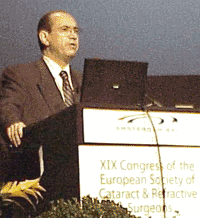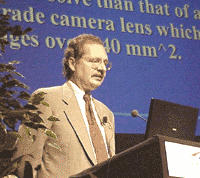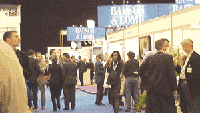Refractive market buoys mood at ESCRS
|
|
AMSTERDAM — With early trials of wavefront-guided and customized ablations showing positive results, the refractive surgery market seems poised to increase beyond its current boundaries. This was perhaps the dominant message that fueled a feeling of optimism here at the 19th Congress of the European Society of Cataract and Refractive Surgeons (ESCRS).
Cataract surgery, too, continues on its path to become the perfect surgical procedure. This was evidenced by the launches of IOLs designed to reduce posterior capsular opacification and provide rejuvenated accommodation, and by presentations on new surgical techniques and tools designed to increase the safety and efficacy of the procedure.
Jose Cunha-Vaz, MD, the current ESCRS president, from Coimbra, Portugal, kicked off the meeting by introducing his successor. Swedish ophthalmologist Ulf Stenevi, MD, will begin his presidency next year, after Dr. Cunha-Vaz’s 2-year term ends.
During the Ridley Medal Lecture, Emmanuel Rosen, FCOphth, of Manchester, England, told attendees that “IOLs paved the way” for refractive surgery. He spoke of the seminal IOL work of his friend and colleague, Sir Harold Ridley, who passed away earlier this year.
Personalized LASIK
Bausch & Lomb made its Zyoptix Personalized Vision Correction refractive laser system the highlight of its ESCRS presentations. Investigations of Zyoptix — a combination of the company’s Orbscan II corneal topographer and Zywave software — have shown “conclusively,” the company said, that patients who undergo LASIK with the system have better vision postop than those undergoing standard treatments.
Bausch & Lomb conducted a double-masked study on 488 patients, randomized with one eye receiving standard LASIK surgery and the other receiving Zyoptix treatment. Patients were given a survey at 1 month postop to assess their opinion of their vision. In the surveys, 19% of patients reported better vision in normal light from the eye that had undergone the Zyoptix procedure; 25% said they had better vision in bright light; 27% stated they had better vision in dim light; and 31% had better ability during night driving. The same patients reported 5% better vision 1 month postop in normal light when LASIK was performed; 10% reported better vision in bright light; 13% reported better vision in dim light with standard LASIK; and 18% reported better sight during night vision after standard LASIK.
Stephen Slade, MD, an investigator of Zyoptix for Bausch & Lomb, said U.S. Food and Drug Administration approval for Zyoptix could come “in about a year.”
Wavefront guided re-treatment
Wavefront guided re-treatment of patients who lost lines of vision due to previous refractive surgery was effective in a small clinical trial, said Julian D. Stevens, FRCOphth, of London.
Re-treatment of higher-order aberrations resulting from decentered ablations was effective in seven eyes of seven patients, Mr. Stevens reported. The original study size was expected to be 40 patients, he said, but with meticulous refraction study, subjects were found not to have lost the vision after all.
“We were very strict in our definition and in our inclusion criteria,” he said.
The re-treatment, performed with the Visx Wave platform, produced objective and subjective improvement in all seven eyes, said Mr. Stevens, who is a consultant for Visx.
“The patients report subjective improvement, but there could also be some placebo effect as well,” he said.
Refractive keynoter
Keynote speaker Raymond Applegate, OD, PhD, spoke about new refractive technologies and high-order aberrations. The idea behind wavefront analysis and treatment, he said, is to remove aberrations without increasing error. Issues to be faced with wavefront technology include healing time and biomechanical error.
“How good is good enough in refractive surgery?” he asked rhetorically.
Refractive surgical results of 20/10 or better are “not realistic,” Dr. Applegate said. But if surgeons believe “20/25 is good enough for postop best corrected visual acuity, refractive surgery can meet those demands,” he added.
Refractive market growth
Anticipated improvements in surgical outcomes as a result of recent technological advances will drive the growth of the refractive surgery market. This was the prevailing theme at a symposium on “New approaches to refractive surgery: LASIK, lenses & more.”
The course, organized by Ocular Surgery News and supported by an educational grant from Allergan, discussed the latest techniques and options available in refractive surgery.
The session was moderated by Ocular Surgery News chief medical editor Richard L. Lindstrom, MD. Presentations included advances in the LASIK procedure by Y. Ralph Chu, MD, refractive lensectomy by Richard B. Packard, MD, targeting emmetropia by Thomas Kohnen, MD, and refractive lens choices (phakic, monofocal and multifocal), presented by Stéphane Ganem, MD, H. Burkhard Dick, MD, and Kevin L. Waltz, OD, MD.
|
|
Test quantifies aniseikonia
A test that is easily performed in the office objectively measures aniseikonia, according to Marie Jose Tassignon, MD, PhD. Dr. Tassignon and colleagues developed a test that takes less than 1 minute per eye and could aid in planning treatment for patients with aniseikonic visual disturbances after surgery.
In the test, patients wearing polarized “aniseikonia spectacles” equalize disparate images displayed on a regular PC screen.
Aniseikonia “can cause visual difficulties, though the patient’s complaint may be vague,” Dr. Tassignon said. IOLs with incorrect refractive powers, changes in axial length after vitreoretinal surgery or asymmetric corneal curvature may be the source of the visual difficulty after surgery, she added.
Phakic IOL in astigmatism
Patients implanted with the Artisan Phakic IOL reported a high degree of patient satisfaction in a study presented by G. Luyten, MD, of the Netherlands. Forty patients treated for hyperopic and myopic astigmatism all report enjoying excellent unaided vision, with no lines of visual acuity lost, Dr. Luyten said.
Mean postop values of astigmatism were reduced significantly, Dr. Luyten reported. One patient, with a preop refraction of –2.00 +14.00 now has 20/25 unaided vision, despite manifesting 4 D of astigmatism, he said.
The procedure will be further improved when the lens can be introduced through an incision smaller than 5.5 mm, Dr. Luyten said.
Debate informs, amuses
Leading ophthalmic surgeons squared off against one another at a special session that provided the audience with not only relief from the routine lecture format but comic relief as well.
The debates were part of a joint session of the International Society of Refractive Surgery and ESCRS, sponsored by Schwind Eye-Tech Solutions.
The session, conceived of by Francesco Carones, MD, placed surgeons against one another in debates over their procedures of choice and how to manage certain clinical cases.
Much of the comic relief was provided by the judges presiding over the procedure-of-choice debate. The judges, dressed in robes and powdered wigs, were Akef El-Maghraby, MD, Gabriel Van Rij, MD, Klaus Ditzen, MD, and Dimitrios Siganos, MD, who at one point threatened to clear the “courtroom” to silence the laughter coming from the nearly 200 people in attendance.
While most presentations were serious, Jan Worst, MD, one of the presenters, joined in the light-hearted nature of the session in his paper on anterior chamber iris-supported IOLs.
The clinical case debates were presided over by Ronald R. Krueger, MD, but the decisions were made by the audience “jury.”
New IOLs debut
A new IOL that includes aspects of a capsular tension ring in its design was introduced at the meeting by Corneal.
The six-haptic IOL is designed for quick sealing to the posterior capsule, but avoids touching the surface of the anterior capsule, according to Philippe Sourdille, MD, who co-developed the lens with German colleagues.
The lens “is performing very well” so far in a small series of implantations, Dr. Sourdille said. The square-edge design lens is composed of mixed hydrophobic and hydrophilic polymers, he said.
The lens already has a CE mark and will undergo wider implantation in a study scheduled to begin shortly. “I’m very pleased with the performance of this lens so far,” Dr. Sourdille said.
With fanfare befitting the opening of a trendy new restaurant, the HumanOptics Group of Erlangen, Germany, introduced its new accommodative IOL, designed by Khalil D. Hanna, MD.
An interpretative dance meant to represent accommodation preceded the announcement of the flexible, hydrophilic acrylic lens as physicians were given their first up-close look at the IOL.
More than 100 of these lenses have been implanted worldwide, according to HumanOptics officials. Since the first lens was implanted in June 2000, no lens-related complications have been reported, officials stated.
Anterior capsule polishing discouraged
Polishing the anterior lens capsule may lead to formation of posterior capsular opacification (PCO), according to Rupert Menapace, MD. Dr. Menapace, of Vienna, and colleagues in the IOL Study Group have abandoned the practice of anterior lens polishing as a result of their findings, he said.
The rate of PCO formation at 1 year was equivalent with or without capsule polishing, but “we predict a higher rate beyond 1 year,” Dr. Menapace said.
The clean-up procedure may interfere with the lens-barrier effect, leading to clouding of the posterior capsule, Dr. Menapace said.
|
|
Quick topical anesthesia effective
Applying lidocaine HCl 4% at 2 minutes before cataract surgery, followed by another dose immediately before the start of the procedure, was found to be equally effective as the usual procedure of dosing beginning 20 minutes prior to surgery.
These were the findings of Federico Marcoli, MD, Laura Frangi, MD, and Luigi Venco in a study conducted in Castellanza, Italy.
This method simplifies anesthetic administration and improves surgical safety by eliminating the development of corneal haze, which often develops as a result of the longer dosing regimen, the authors said.
‘Karate pre-chop’
Splitting the nucleus like performing a karate chop significantly reduces the time needed to remove a cataract, according to Takayuki Akahoshi, MD.
“If you bisect the cataract and then rotate it to perform another bisection, the cataract can be easily removed,” Dr. Akahoshi told the audience. In a real-time video, Dr. Akahoshi demonstrated his technique, which allowed him to perform cataract surgery — including IOL implantation — in 1.29 minutes.
Spoon enhances cataract photolysis
A hand piece consisting of a disposable probe with a spoon shape at the tip, created by W. Wehner, MD, improves cataract photolysis, shortens surgery time, increases safety and allows the surgeon better handling, according to a presentation by Jack Dodick, MD.
Dr. Dodick said the new hand piece could potentially be used in 80% of cataract cases. An advantage of the probe is that it can be introduced into the anterior chamber through a 1.5-mm incision. Acrylic lenses in development by ARC Laser, which manufactures the laser used in Dodick photolysis, will fit through that same 1.5-mm incision, Dr. Dodick said.
Testing of the lenses was scheduled to begin in late September, Dr. Dodick said.
Vitrectomy for dislocated lens
Pars plana vitrectomy and IOL implantation for the management of crystalline lens dislocation was effective with low complication rates, according to a study presented in a poster here.
The study, a retrospective analysis of 200 cases conducted by W. Omulecki, MD, of Poland, demonstrated that primary pars plana vitrectomy is an effective method for dislocated lens removal, with good visual rehabilitation via IOL implantation.
The etiology of the dislocated lenses included trauma, congenital, iatrogenic or unknown reasons. Pars plana vitrectomy was performed, with limbal extraction in 192 cases and with lensectomy in eight. Perfluorocarbon liquid was used to elevate the luxated lens in 26 eyes. Anterior chamber one-piece open-loop IOLs were implanted in 42 cases, scleral fixation of a posterior chamber IOL was done in 114 cases, and no IOL implantation was done in 44 cases.
The final mean best corrected visual acuity was 0.64 in eyes with posterior chamber scleral fixated IOLs and 0.54 in eyes with anterior chamber IOLs. Similar results, 0.54, were achieved with adequate correction in the aphakic eyes. Overall, 72.5% of eyes improved, 18.5% had no change, and 9% got worse.
The most severe complications were retinal detachment in five eyes, uncontrolled glaucoma in three eyes and bullous keratopathy in two eyes.
Age and glare not related
No significant correlation exists between age and glare in pseudophakic patients, according to a poster presentation by Sinisa Avramovic, MD.
Dr. Avramovic and colleagues from Belgrade, Yugoslavia, monitored 152 eyes of 98 patients with pseudophakia in one or both eyes. A wider age difference among patients may be needed to determine correlation between age and glare, the researchers note.
IOL choice should involve glare concerns
Surgeons striving for quality of vision in their post-cataract surgery patients must take into account the possibility of postoperative photic phenomena, according to Olivia Serdarevic, MD.
Lenses with high refractive indices and flat anterior surfaces are more likely to cause disturbing glare symptoms, Dr. Serdarevic said. The source of glare in these IOLs is internal retinal reflection, she said.
The CeeOn lens from Pharmacia has addressed this issue and other problems as well, such as posterior capsular opacification, Dr. Serdarevic said, by offering a square-edged optic with a lower refractive index and steep anterior surface.
Cataract surgeons must balance different aspects of IOL performance in order to provide excellent visual results after cataract surgery, Dr. Serdarevic said. Cataract surgeons will increasingly demand better performing materials and designs and patients will expect better results from cataract surgery as well, she said.
CO2 for deep sclerectomy
Studies conducted with animal and cadaver eyes have shown that using a CO2 laser for non-penetrating deep sclerectomy is safe and effective, said Ehud Assia, MD.
A decrease in intraocular pressure in rabbit eyes was maintained for 21 days, Dr. Assia said, and effective fluid percolation was seen in all 20 cadaver eyes. No obvious damage was evident in the adjacent tissue.
Dr. Assia said the CO2 laser (Kaplan Pendu Laser 15, Optomedic) will enter U.S. clinical trials “shortly.”
The cadaver eyes studies were conducted under the supervision of David Apple, MD, at the Storm Eye Institute in Charleston, S.C., Dr. Assia said.
Excimer for deep sclerectomy
Performing deep sclerectomy with excimer laser may prevent some of the complications of trabeculectomy with no risk of intraoperative perforation, according to David Badozza, MD.
During glaucoma surgery performed on 20 patients, if intraocular pressure failed to fall below 16 mm Hg, an opening of the trabeculo-Descemetic membrane with Nd:YAG laser was per- formed and a collagen implant was inserted. No perforations occurred during ablation, and neither shallow anterior chamber nor choroidal detachment was observed, Dr. Badozza said.


 Raymond Applegate, OD, PhD, delivered the keynote address to attendees at the XIX Congress of the ESCRS.
Raymond Applegate, OD, PhD, delivered the keynote address to attendees at the XIX Congress of the ESCRS. 